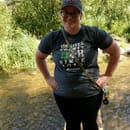Plastic comes in a variety of shapes, sizes, uses, and material. All plastics are made from different polymer chains, and each type is different. Some plastics are easy to recycle while others aren’t. Other plastics are harmful to humans while others are relatively safe to use. So which is which? In 1988, the Society of Plastics Industry developed a code which would allow recyclers to be able to tell the difference between plastic types. The code is still in use today, and has spread to other countries around the world. If you’ve used any type of plastic ever, you’ve definitly seen this code.
Each number inside the triangle represents a different type of plastic. Knowing which numbers are recyclable and which are reusable is important.
#1: PET or PETE- Polyethylene Terephthalate
PET plastics are one of the most common plastics we see everyday. They are found in water and pop bottles and food packages. PET is intended for single use applications, so reusing that plastic water bottle isn’t the best idea. Repeated use of a PET product increases the risk of chemical leaching and bacterial growth. PET plastics are difficult to decontaminate and proper cleaning requires harmful chemicals. They are the easiest plastic to recycle. PET plastics are recycled into new PET bottles or made into polyester fibers which get used to make fleece garments, carpets, and stuffing for pillows and life jackets.
#2: HDPE- High Density Polyethylene
HDPE plastics are hard-wearing and don’t break down under exposure to sunlight or extreme temps (both heating and freezing). For this reason, HDPE is used in packaging for detergents, bleach, milk containers, toys, some plastic bags, picnic tables, plastic lumber, waste bins, park benches, bed liners for trucks, recycled plastic garden beds, and other products that require durability and weather-resitance. HDPE plastics are the easiest to recycle, and are considered one of the safest forms of plastic.
#3: PVC- Polyvinyl Chloride
PVC plastics are one of the more difficult plastics to recycle. They are found in many products we encounter everyday, including pipes, toys, furniture, packaging, clear plastic food wrap, cooking oil bottles, teeting rings, window frames, and garden hoses. PVC leaches toxins during it’s entire life cycle, making it a major environmental and health threat. Less than 1% of PVC materials are currently recycled.
#4: LDPE- Low Density Polyethylene
LDPE plastics are less toxic than other plastics and are relatively safe to use. LDPE products are reusable but not always recyclable. It is used in shrink wraps, dry cleaner garment bags, squeezable bottles, plastic bags that bread comes in, and sandwich bags. When it is recycled, it gets recycled into plastic lumber, landscaping boards, garbage can liners, and floor tiles.
#5: PP- Polypropylene
PP plastics are used in cereal box liners, disposable diapers, pails, plastic bottle tops, margarine and yogurt containers, potato chip bags, straws, packing tape, rope, and some clothing. PP plastic is tough but lightweight, and has excellednt heat-resistant qualities. It is used as a barrier against moisture, grease, and chemicals. PP is considered safe for reuse.
#6: PS- Polystyrene
Polystyrene, also known as styrofoam, is very difficult to recycle and is a huge problem for the environment. It is found in disposable styrofoam cups, take-out “clamshell” food containers, foam packaging, packing peanuts, food trays, and egg cartons, and rigid foam insulation. It can be reused, but is structurally weak. Styrofoam breaks easily, which allows it to be dispersed in the environment easily. PS plastics may also leach styrene into food products, especially if the plastic is heated in a microwave. Styrene has been linked to reproductive system dysfunction, and should be avoided whenever possible.
#7: Other
Plastics marked #7 can be a mixture of numbers 1-6 or plastics that are not ready to be recycled, like polyurethane, acrylic, polycarbonate, polyactic fibers, nylon, and fiberglass. They are used in baby bottles, sippy cups, water cooler bottles, and car parts. The main concern with #7 plastics is the potential for chemicals to leech into food, mainly BPA. BPA (Bispheonol A) is a xenoestrogen, which is known to disrupt the endocrine process in our bodies. #7 plastics are not recommened for reuse, and most recyclers don’t want it. #7 plastic is starting to be replaced with compostable plastics made from bio-based polymers, like corn starch.
Recycling plastic varies depending on your location. Most places in the US won’t take plastics marked #3 or #5. Fortunately for us, UW Stout collects plastics marked #1-7. Part of reducing our plastic use is replacing plastics with reusable items, like beeswax food wrap, silicone food containers, reusable drinking straws, and reusable grocery store bags.


